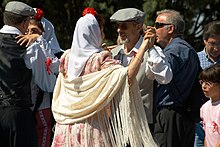Schottische
The chotis is a music and dance originating in Bohemia. Its name derives from the German term Schottisch ("Scottish"), a Central European social dance that in Vienna wanted to attribute its origin to a Scottish dance. Various variants of schottisch survive in the Argentinean (schotis), Austrian, Brazilian (xote), Scandinavian (schottis) >), Spanish, Finnish (sottiisi), French (scottish), Italian (chotis), English (scottische), Mexican (chotís), Paraguayan (choti), Portuguese (choutiça or chotiça), Swiss and Uruguayan (chotís or xote). It became fashionable in almost all of Europe during the 19th century and spread to America. The chotis is a tight and slow dance that is usually executed taking three steps to the left, three to the right and turns. At the moment when the music changes, the couple must change the circular direction of the movement. The key to the whole process is in the feet.
Argentinian, Paraguayan and Uruguayan chotis
In Argentina, Paraguay and Uruguay, the schotis or chotis was introduced by Volga German immigrants and settled Poles beginning in the second half of the century xix, in the coastal region of the Paraná, Paraguay and Uruguay rivers that make up the Río de la Plata Basin. It constitutes one of the outstanding styles of what in Argentina is called coastal music. The chotis accompanied the entry into the region of one of its most characteristic instruments, the diatonic accordion, with one and two rows, which was added to the guitar to form the typical peasant or "campirinha" orchestra. Once installed, the chotis merged with the folk music of the region, strongly influenced by the Guarani indigenous culture, adopting the characteristics that distinguish it. After merging with the music of Guarani indigenous origin, it gave rise to the modern chamamé.
Brazilian chotis
The xote is the Brazilian version of the dance and is considered to have arrived in the country by immigrants from Germany in the 19th century; although it is known in Portugal as "chotiça" it is probable that the dance reached the two countries separately as a repertoire that accompanied the introduction of the accordion. In those years the various styles of dance were popular among the upper classes of Brazilian society, especially during the reign of Pedro II.
Mexican chotis
Written shotis, it was introduced in Mexico around 1850, in the dance halls frequented by the lower classes. A more rustic style was popularized at house parties and public dances. It is preserved in northern Mexico, particularly in the states of Chihuahua, Nuevo León, Tamaulipas, Durango, Sinaloa, Zacatecas, with styles typical of each place.
Chotis from Madrid
The chotis arrived in Madrid in 1850 and there has been news that it was danced for the first time in the Royal Palace, on the night of November 3, 1850, under the name of 'German polka'. It later became popular and the traditional dance par excellence of the people of Madrid.
It is danced in pairs to the sound of a barrel organ, and during the dance the woman revolves around the man, who in turn revolves around his own axis, which is why the saying has become popular that "don't you need more than a brick" to dance it. It is typical to see him dance in the open-air festivals of Madrid, the women dressed in a Manila shawl and scarves covering half the head, and the men, always looking straight ahead and dressed in a vest, striped pants and a parpusa or cap with a visor.
Contenido relacionado
Murder in February
Martial (disambiguation)
Yngwie Malmsteen

